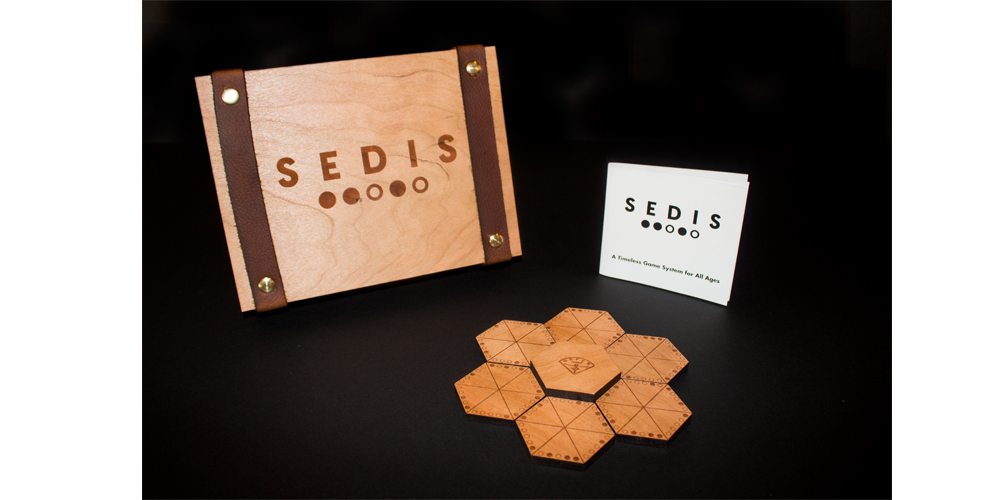
Live on Kickstarter now, Sedis is not your average game. In fact, Sedis is a gaming system composed of 60 unique wooden hex tokens. Each token is marked with 30 spaces, 10 of which are colored in, making the tokens a nuanced platform on which to base new games and puzzles. Sedis sets come in birch and cherry wood, at thicknesses of 1/4″ or 1/8″, depending on backing level. Let’s look at how Sedis works, and whether it’s for you.

Sedis is made of 60 6-sided tiles, each with five spaces, with 1-3 of those spaces filled in. Spaces which are filled in are called “pips,” like the dots on a die or dominoes. The empty spaces are called “blanks.” One side of each tile has 3 pips, which is called the “primary” side. There are two sides with 2 pips each, and three sides have 1 pip each. The primary side determines which spaces might have pips. The combinations of the 1-pip sides determine the 2-pip sides. No two tiles are the same, though there are matches for any given side. The primary sides come in 10 varieties, called “families.” These families cover all possible combinations of 3-pip patterns.
So, what does one do with these tiles? There’s no limit. Sedis is designed to be played with any kinds of games, as designed by the players. Much like dominoes and dice, Sedis is a universal gaming system. Now, the Sedis Kickstarter asserts that Sedis is only the 4th universal gaming system, which GeekDad doesn’t agree with. Other universal game systems include 6-sided (classic) dice, the D20 system, Looney Pyramids, dominoes, playing cards, glass bead game (AKA Mancala, among others), and Piecepack. So Sedis is decidedly not the 4th, but that doesn’t take away from the system. It’s just an odd and inaccurate claim to make. UPDATE: Sedis has removed this claim after much feedback and support from online gaming communities. You can see their statement here.
Games:
The game comes with three example games to try called Honeycomb, Rings, and Spokes. We found Honeycomb to be too easy and Spokes to lack sufficient rules to play. Rings, however, has proven to play well. I also designed a couple of games, which I think are pretty okay. They are called All or Nothing and Grain.
Rings
Rings is a game in which players match up the 1-pip sides of tiles, and create circles. Much like Dots and Boxes, players who close a ring are awarded a point. One can tally points as play progresses, or one can use some kind of token to mark who has completed each ring. Each side must reflect each other exactly to add a tile, though, so some strategy is needed to be able to complete each ring.
Multiple rings can be complete by a single placement, as shown above. The player who closes the rings gets to claim all completed rings. In this case, Dark Blue scores 3 points, leaving Blue and Black to scramble.
All or Nothing
All or Nothing is a variation of the Honeycomb game. In Honeycomb, players can place a tile wherever they like, and score points for matching pips. In All or Nothing, however, each side has two requirements: Either the pips must reflect each other exactly, or no pips on that side may match. Players get 1 point for each matching pip, and 1 point for each matching side. Players have 3 tiles in their hand at a time during their turn, and may not discard tiles. The game is over when the last token is placed.

In this picture, you can see the basic play of All or Nothing. Three tiles are drawn by the players, who place them according to the rules. They score no points for this first placement, however, it’s just the framework. Players determine the first player by their preferred means. The first player places their tile, which has one “All” side, and one “Nothing” side. The player scores two points for the matching pips and two points for the two sides they match. The next player places a tile, again with one “All” side and one “Nothing” side. They score 5 points, 3 for matching pips, and 2 for matching 2 sides. At most, a player can place a tile for 16 points, but this is nearly impossible. They must exactly match all 10 pips inside a ring of 6 other tiles.
Grain
Grain takes its inspiration from the beautiful cut of the natural wood tiles. In Grain, players can place tokens however they like, so long as the grain runs in the same direction as the first piece placed. Points are scored for each matching pip. Players have a hand of 5 tokens, and the game is over when the last tile is placed.

Here you can see the beginnings of a match. The first four plays attach tiles in the same orientation. Players can change the direction of the grain by placing an exact reflection of a tile at a different angle. Future tiles may be placed in either direction, provided they are oriented in the same direction as the pieces they are attached to. Grain is a bit more restrictive, but encourages players to think creatively and to place their tiles carefully.
Non-game uses for Sedis
Sedis tiles are quite flexible, which means they are great for a number of other uses including logic puzzles, or code breaking. In the picture below, you can see how only some tiles are face-up. This particular arrangement can be employed for a number of challenges.

Logic
The first is a logic puzzle. If you have a group of people (such as your D&D party) that needs to navigate a map with special properties, it can be represented on Sedis tiles. One premise is that each pip represents the number of people who can pass from one tile to the next. Going from left to right, assume two people can go forward (right), but only one can go back (left). Players may have to negotiate an entire map composed of this mechanic, making it difficult to loot a dungeon or escape quickly.
Hidden Messages
Since Morse Code is made up of dots and dashes, one can spell out messages using the combinations of pips and blanks. The only letter I found that cannot be represented is the letter H, because it requires 4 consecutive pips, which don’t exist on Sedis tiles. Nevertheless, a codex mapping the order and orientations of the tiles to be read can be employed to spell out hidden messages for the challenger to decipher.
Backing on Kickstarter has a number of options. Starting at $45, players can get a full 60-tile set of 1/8″ birch tokens. Higher tiers include rewards such as cherry wood tiles, thicker tiles, a box for your tiles, and even custom engravings on the box and tiles.

The set I was sent to test are quite nice. The cherry wood tiles are laser-cut, which makes for a very crisp final product with naturally darkened edges. When you first take them from their bag, they smell slightly smokey, but that dissipates rapidly. The bag is soft but durable, much like other quality game-component pouches, and has silky drawstrings which make it easy to open and close. The tiles stack nicely and the bag is easily held in one hand. Overall, I’d say the components of a Sedis set are beautiful, higher than average quality, and entirely satisfying.
The Sedis Kickstarter campaign is live now, and will run until Sat, May 27 2017 5:31 AM MST. Backing starts at $5 for folks who want a “cookie”—a single Sedis tile—as a thank you.
Disclaimer: Nefer Games provided a copy of Sedis for testing purposes.







